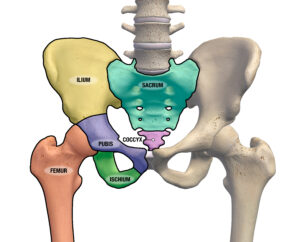The pelvis is a basin-shaped complex of bones that connects the trunk to the legs. It is best described in 1958 by Dr Fred Mitchell Snr (MD, Osteopath).
“Is the crossroads of the body, the architectural centre of the body, the meeting place of the locomotive apparatus, the resting place of the torso, the temple of the reproductive organs, the abode of the new life’s development, the site of the two principle departments of elimination, and last but not least, a place upon which to sit…”
Dr Fred Mitchell Snr (MD, Osteopath)
Structure:

The pelvis is a relatively closed compact unit consisting of:
- Paired innominate (hip or coxal). Large irregular bone formed by three parts: ilium, ischium, and pubis. Which fuse together and ossify by the age of 25.
- Sacrum a large, triangular bone at the base of the spine. Which forms by the fusing of the sacral vertebrae (S1–S5) between ages 18 and 30.
- Coccyx commonly referred to as the tailbone, it is the final segment of the vertebral column.
Connected via three joints:
- Pubic synthesis is a secondary cartilaginous joint. Located between the left and right pubis of the hip bones. It is in front of and below the bladder. In most adults it can be moved roughly 2mm and with 1 degree rotation.
- Two sacroiliac joints (SIJ) join the hip to the sacrum. They are a strong, irregular synovial plane joint connected by 5 strong ligaments. The SIJ’s supports the entire weight of the upper body that are capable of only a small range of movement.
Importance:
The pelvis has major participating roles in daily life. First allowing us to stand and walk, it supports the entire weight of our upper body. Along with the pelvic floor musculature it protects and holds up all our internal organs. Finally, it aids in childbirth creating part of the birth canal.
Male Vs Female:

The general structure of the female pelvis is thinner and less dense. The male pelvis, in comparison, is thick and heavy, which is designed to support a heavier body frame. The female pelvis is considered oval in shape (aids in childbirth). Compared to the female the male is considered more heart shaped.
The sacrum of the female is shorter, wider, and has a greater curve. The female coccyx is straighter and more posterior. Whereas, the male sacrum is thinner, longer, and is less curved than the female counterpart. The coccyx curves more toward the front of the body.
The acetabular (cup-like sockets of the hip) are smaller and farther apart in females, while men have larger acetabula that are closer together.
References:
- https://anatomypubs.onlinelibrary.wiley.com/doi/full/10.1002/ar.23561
- https://www.ncbi.nlm.nih.gov/books/NBK482258/
- https://www.mentalfloss.com/article/502708/7-essential-facts-about-pelvis
- https://teachmeanatomy.info/pelvis/bones/pelvic-girdle/
- https://courses.lumenlearning.com/ap1/chapter/the-pelvic-girdle-and-pelvis/
- https://anatomypubs.onlinelibrary.wiley.com/doi/epdf/10.1002/ar.23561
- https://3d4medical.com/blog/differences-between-the-male-and-female-bony-pelvises-anatomy-slices#:~:text=The%20general%20structure%20of%20the,support%20a%20heavier%20body%20build.&text=A%20male%20pelvis%20has%20a,pelvis%20at%20about%20%3E80%C2%B0.
- https://www.registerednursern.com/male-vs-female-pelvis/







